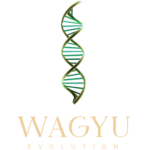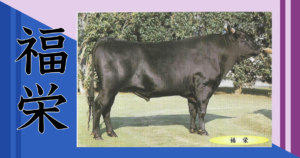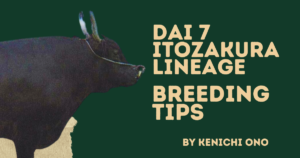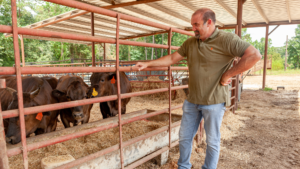Dai 7 Itozakura: The Premiere Growth Bull
Table of Contents
* Note: This is not a direct translation of Kenichi Ono’s “Top 100 Famous Beef of Japan [Revised Edition]” but a summary that was written using it as a direct source.
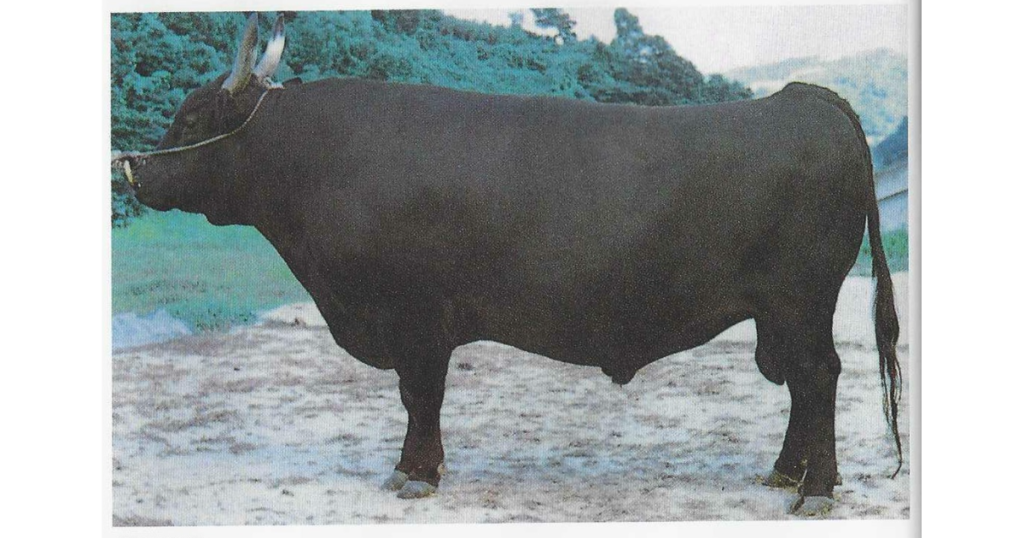
Figure 1. Dai 7 Itozakura
Early Life
The representative growth bull “Dai-7 Itozakura” was born on December 10, 1970, at the home of Kazuyoshi Saeki in Yokota, Shimane Prefecture. His sire was Shigeru from the Okayama line, and his dam was Dai-9 Itozakura from the Hyogo line, making him the seventh calf.
In May of the following year, he came into the ownership of Kunio Horio, a bull breeder, and underwent direct testing at the Prefectural Livestock Experiment Station (Direct Test DG 1.38 kg).
In March 1972, at the bull sale held at the Izumo Livestock Market, he narrowly missed being selected by the representatives from Okinawa Prefecture due to his knock-kneed hind legs, which were deemed unsuitable for grazing. The fate of Dai-7 Itozakura was to remain in Shimane Prefecture. Notably, many renowned bulls in Japan have had some shortcomings, which sometimes led to them being sold out of their local areas or, as in the case of Dai-7 Itozakura, remaining local and achieving greatness. Such twists of fate can be quite mysterious.
Becoming the property of Shimane Prefecture, Dai-7 Itozakura began his service in April 1972 and, over more than ten years until August 1982, produced approximately 100,000 straws of semen. He passed away on August 24, 1982, due to an abdominal tumor, at the age of 11 years and 8 months. Had he been healthy, he was scheduled to be exhibited as a reference bull at the 4th National Wagyu Exhibition (Zenkyo) in Fukushima the following month, making his death just before this big event all the more unfortunate.
The indirect testing of Dai-7 Itozakura, which concluded in March 1975, marked the beginning of a new era in the history of Wagyu improvement. His records of an average daily weight gain (DG) of 1.02 kg and a marbling score (BMS) of +3.4 (under the old system) were noteworthy. At that time, there were very few Black Wagyu bulls that exceeded 1 kg in DG in indirect testing, making Dai-7 Itozakura a pioneering figure in the field.
Features
Strengths: Growth, gentle temperament, early maturity, rib-eye area, reproductive ability (both milking ability and fertility), suitability for grazing, adaptability to group feeding.
Weaknesses: Poor uniformity, coarse bone structure, meat texture, slightly lacking in flavor and fat quality, facial appearance issues, and less marbling in the thighs.
Bulls like “Anbi Doi” and “Kikutsumi Doi” had average daily weight gains (DG) around 0.75 kg. At the time, there was a growing trend towards economic fattening, and within just a few years after the conclusion of indirect testing, Dai-7 Itozakura established itself as the “most economically efficient Wagyu in Japan.”
During this period, Shimane Prefecture was experiencing the peak of the renowned Keitaka line with the famous bull “Harumi.” Naturally, calves resulting from crosses between Harumi’s daughters and Dai-7 Itozakura became dominant in the calf market, leading to improvements in the production of breeding bulls and the upgrading of breeding stock. Five years after Itozakura’s death, the 5th National Wagyu Exhibition (Zenkyo) held in Shimane saw outstanding results, including top awards in the fattening cattle category and high placements in various other divisions, marking the peak of Shimane Wagyu’s prominence.
Pedigree Background
Dai-7 Itozakura’s sire, Dai-14 Shigeru, was a grandson of Dai-6 Fuji-ryo from Okayama Prefecture, which is why Itozakura is referred to as part of the Fuji-ryo line. Dai-14 Shigeru did not produce any particularly notable bulls besides Itozakura, with only three bulls—”Itochiyo,” “Kurae,” and “Shizu” from Hokkaido—recorded. Additionally, no outstanding bulls were produced from the other 12 siblings of Itozakura. In this sense, Dai-7 Itozakura can be viewed as a rare mutation in the national context.
However, Itozakura’s dam, Dai-9 Itozakura, came from the Hyogo line, which was scarce in Shimane Prefecture. Her sire, Shiro-matsu, was a grandson of the renowned Hyogo bull Tajiri, and Shiro-matsu’s maternal grandsire was the elite bull Netsudo, indicating a solid foundation for producing high-quality meat.
Furthermore, Dai-9 Itozakura was known for her high reproductive ability, having produced 13 offspring in her lifetime (5 females and 8 males). This high reproductive capacity supports the strong reputation of Dai-7 Itozakura’s progeny.
Major Successor Bulls
Bulls with Dai 7 Itozakura as the Sire:
- Itofuku (Oita Prefecture)
Many Itozakura line bulls are used in Kyushu, with notable bulls including Ito-Nami, Ito-Haru (both from Saga Prefecture), Kita-Kuni 7-3 (Okinawa → Kagoshima), and Ito-Hiro 2 (Miyazaki). Among these, Ito-Fuku is now well-known outside Kyushu and is a regular top finisher in the meat quality competitions across western Japan, centered in Osaka.
Ito-Fuku’s notable traits include good growth, large rib-eye area, adaptability to group feeding, and a tendency to produce high-quality meat. His excellent ability to produce offspring further reinforces the strengths of the Itozakura line. Ito-Fuku’s slightly older sibling, Ito-Ryu, also shows similar traits, although it has slightly narrower rib-eye and some variability. Both Ito-Fuku and Ito-Ryu support the brands “Bungo Beef” and “Saga Beef” (both are active).
- Ito-Harunami and Itohana (Shimane Prefecture)
Both of these bulls initially had limited use due to their pronounced long and short traits, but they became popular later in their lives.
Ito-Harunami prominently inherited the traits of Dai-7 Itozakura, including its longer body and thicker bones. However, these traits were less apparent when crossed with females from the Hyogo line or other lines with thinner bones and less growth potential. Instead, the offspring from such crossbreeding exhibited exceptional growth and stable meat quality. Despite this, the variability in inbreeding led to a lasting negative image. The offspring, Kiyo-Sakura, inherited Ito-Harunami’s positive traits but died young (Ito-Harunami died in 1990).
Itohana, with its shorter legs, lower height, and predominantly solid black calves, initially had a lower reputation as a breeding cow. Although it did not spread widely despite its test results, it was one of the bulls that inherited Dai-7 Itozakura’s meat quality traits most strongly. It produced many high-quality cattle, both within Japanese breeds and beyond. If the breeding value had been more widely promoted a decade earlier, Itohana’s breeding value and BMS (Beef Marbling Score) would have undoubtedly ranked among the top nationwide. Its offspring, Hana-Sakura, is one of the bulls that inherited Ito-Hana’s excellent meat quality traits (Itohana died in 1994).
- Itofuji (Kagoshima Prefecture, Kojyo Artificial Insemination Center)
While Itofuji is associated with famous bulls from Okayama Prefecture, the namesake bull currently used in the Ooguchi area of Kagoshima Prefecture is also becoming a notable breed. In 1995, Ito-Tou’s performance in Kagoshima Prefecture was highly regarded.
In evaluations of sire bulls, BMS (Beef Marbling Score) ranks second only to Kamitakafuku, while growth performance ranks third out of 31 bulls recorded, reflecting a well-balanced field performance in both meat quality and growth. This is good news for Kagoshima Prefecture, which has a high number of Kida-line bloodlines.
Other Itozakura Line Stud Bulls:
- Miyazakura (Akita Prefecture)
- Good weight gain but somewhat variable. Declined in later years.
- Itoshimizu (Fukushima Prefecture)
- Good weight gain, robust, and well-received but possibly showing some decline in ability.
- Itofuku (Gifu Prefecture)
- Same name as the bull from Oita. Expected to be the best in post-evaluation in Japan but suddenly died in June 1995. A very promising and unfortunate loss.
- Itomamoru (Shimane Prefecture)
- Local star of hope. Slightly higher incidence of skeletal abnormalities.
- Itokitazuru (Tottori Prefecture)
- Good weight gain and high economic value.
- Itofuji (Okayama Prefecture)
- Renowned bull of its era. Made significant contributions to both breeding and fattening farms. Produced Fujisakura (Shimane)
- Tanimizu (Breeding Association)
- Well-received by fattening farmers, especially in Hokkaido, for its weight gain and robustness but declined in later years.
- Kagetou (Breeding Association)
- Apart from the slight weakness in shoulder width, its meat quality was top-class within the Itozakura line. Its few offspring are still active, and its early death is greatly regretted.
- Itoharumi (Nagasaki Prefecture)
- Rapidly spread throughout the prefecture, with few flaws.
- Toryu (Hokkaido)
- Good body shape and stable meat quality, with high future expectations.
Breeding Considerations & Recommendations
Itozakura lineage sire bulls include those with stable and good growth types (e.g., Tani-Mizu, Ito-Maku) and those with somewhat variable growth but excellent meat quality (e.g., Sai-Fuji, Kita).
Types of Itozakura Lineage Bulls:
- The first type includes bulls with stable meat quality in their maternal lines. For these bulls, the maternal line should have a well-balanced growth and meat quality.
- The second type includes bulls with somewhat variable growth but excellent meat quality. For these bulls, using a maternal line with good balance between growth and meat quality (e.g., Yasu-Fuku lineage) can help in achieving more uniform offspring.
Vitamin A Deficiency
Itozakura lineage offspring tend to be particularly susceptible to Vitamin A deficiency. It is crucial to consult with experts in both fattening and breeding to avoid accidents. In breeding cattle, issues may include infertility or weak offspring, while in fattening cattle, it can lead to respiratory diseases or edema.
Early Maturity
Itozakura lineage sire bulls are extremely precocious. Consequently, there are noticeable cases of diminished ability in their later years. It is important to consider incorporating slight late-maturing traits from other lineages (e.g., Harumi from the Kiko line or Hyogo-Kikumi) to improve future generations.
Genetic Diseases
Although the Itozakura lineage does not seem to be associated with known genetic diseases, the characteristic defects such as excessively large bones (skeletal abnormalities) and extreme variability in growth should be treated as genetic issues. Future breeding should focus on improvement through crosses with Kiko lineage or Shige-Kane lineages.
Ideal Breeding Model 1:
- Kita-Kuni 7-8 × Shige-Katsu or Shige-Itoha
- Shige-Nami Fuku
- Taira-Shige-Katsu × Yasu-Fuku 165-9
- Miyafuku-Shige × Kita-Kuni 7-8
References
小野健一. 日本名牛百選〔改訂版〕(pp.23-40). 肉牛新報社.
